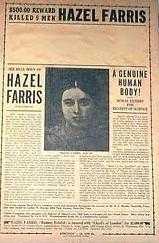Hazel Farris

The purported mummified remains of Hazel Farris (c. 1880 – December 20, 1906) traveled the American South and were displayed for a long time at the Bessemer Hall of History in Bessemer, Alabama as Hazel the Mummy. After appearing in a television documentary, her remains were cremated by her Nashville owners.
The story
According to a broadsheet Hazel Farris lived in Louisville, Kentucky with her husband and they were both hard drinkers. An argument over the purchase of a new hat led to blows and Hazel ended up shooting her husband. Hearing gun play, the neighbors summoned the police, but Hazel dispatched the three responding officers as well. A deputy sheriff gained entry and attempted to restrain her, shooting off one of her fingers in the process. He was also killed. A Check of the ODMP listing however shows that no Kentucky—or any other-Lawmen were killed August 6, 1905—the date these killings are alleged to have occurred.
With a $500 reward for her capture, Hazel fled to Bessemer to begin a new life. She took up with a man (some say a police officer) who ended up selling her out for the reward, when Hazel told him who she really was. Hazel committed suicide by drinking gasoline and arsenic before the police could arrive. This was December 20, 1906.
The corpse
|
|
Hazel's body was taken to Adams Vermillion Furniture which also sold caskets and functioned as a funeral parlor. No one showed up to claim her, but the body wasn't decomposing, either—supposedly an effect of the poison. With an endless supply of curious visitors the proprietor started charging 10¢ a gander to see the notorious outlaw. The corpse was later loaned out to various exhibitors, including Adams' brother in Tuscaloosa, and Captain Harvey Lee Boswell, before it came into the possession of O. C. Brooks in 1907. He featured the well-preserved remains in his traveling show for 40 years. When he died, Brooks left Hazel to his nephew, on the condition that any money raised from displaying her be donated to charity.
As the story goes, Brooks' nephew used Hazel to raise money to build churches in Tennessee before bringing her back to Bessemer, where she became an infamous attraction at the newly formed Hall of History. After a long run, and an appearance in a National Geographic Channel documentary, Hazel's owners decided to finally lay her ashes to rest.
Questions
An autopsy performed for the documentary indicated that the mummified woman died of pneumonia. A finger was, indeed, shot off about a year before her death. The procedure further determined that the body was replete with arsenic, but it appeared she had been immersed in, not ingested, that particular poison.
Bessemer had no embalmers in those days, so any preservation bath would have been done by amateurs using materials at hand. The documentary makers found no archival evidence from newspapers of these events, leading to the assumption that the story was crafted to fit the remains.[1]
References
- Katz, Elaine S. (Winter 1978) "Variation as Relative Perception in the Legend of Hazel Farris". Mid-South Folklore Vol. 6, No. 3, pp. 55–64
- Abrams, Vivi. (November 1, 2004) "Bessemer mummy legend endures." Birmingham News.
- "National Geographic probes story of Ada mummy." Claremore Daily Progress
- "An Unwanted Mummy". The Mummy Road Show Episode 12. National Geographic Channel (April 1, 2002)
- Quigley, Christine. (1998) Modern Mummies: The Preservation of the Human Body in the Twentieth Century. Jefferson, North Carolina: McFarland & Company. ISBN 0-7864-0492-2
- Conlogue, Jeremy and Ron Beckett. (September 2005) Mummy Dearest:How Two Guys in a Potato Chip Truck Changed the Way the Living See the Dead ISBN 1-59228-544-9